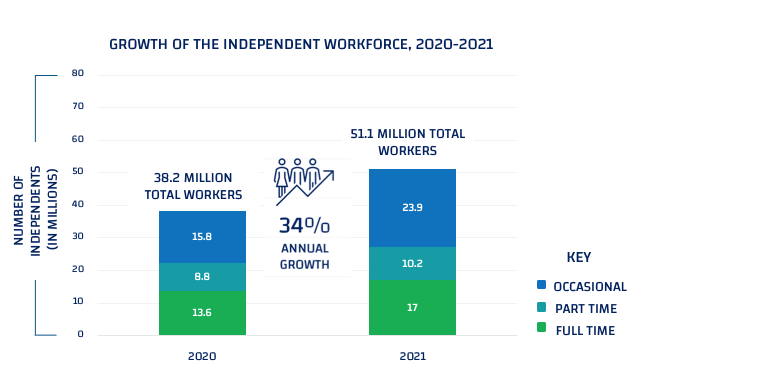From Great Resignation to Great Realization: Independent Work Numbers Surge in the Wake of COVID-19

In 2021, the number of independent workers grew to 51.1 million, up 34% from 2020. Welcome to the Great Realization.
Let’s face it, times are changing and the American workforce is rampantly becoming less and less like what you see in old 80’s and 90’s movies. You know, the ones where people drudge themselves to work each morning, drink a whole pot of coffee themselves, and try to make it through endless conference meetings, spins in their chair near their designated cubicle, and for the ladies, kick off the pair of overpriced dreadful high heels they bought to make themselves look more ‘serious.’
Instead, people are letting go of this long-time image of what a 9 to 5 job looks like. As we’ve been reporting now for 11 years, people are becoming increasingly more and more independent. And no, it’s not just a Gen-Z or millennial trend; it’s a global shift in the way we work today.

The Independent Workforce IS The Future of Work
It’s nearly impossible to separate the independent workforce from the future of work as a whole. That’s because as of 2021, more than half the U.S. workforce is, or has been, independent at some point in their careers, a number that is likely to grow.
Independence is a lifestyle attracting the very best in their fields, as well as those looking to earn extra money, pursue passions, enjoy added flexibility to care for a child, parent, or manage a lifestyle shift, and also a way for people to enjoy a fulfilling career that extends well beyond the bounds of traditional retirement age. While we may call these workers many things: giggers, consultants, freelancers, contractors, solopreneurs, microbusiness owners, entrepreneurs, and more, they’re all part of a larger community: the independent workforce.
Key Trends to Watch
In advance of our larger study, we’ve broken down 5 quick trends we think will be ones to watch throughout the year.
- Side Hustle To The Rescue
Businesses are a game of profit and loss — if they’re profitable, they continue and grow, and if they have too much loss, they’ll eventually cease operations. The COVID-19 crisis illustrated one of the worst recessions in recent memory, and an unprecedented shuttering of businesses worldwide. As a result, workers lost their jobs. While we’re well into a recovery, today, there are 6 million fewer Americans employed than before the pandemic and millions more have seen their hours reduced. As a result, we’ve seen a surge in workers pursuing independence part-time to replace lost income, with 10.2 million part-time independents this year, up from 8.8 in 2020, while those who work independently occasionally, are up to 23.9 million from 15.8 million in 2020. In fact, 58% of full-time independents say they earn more money than they would be employed in a traditional job.
-
Women Respond to the She-Cession:

Over half (55%) of new entrants to the independent workforce this year identify as female. Data from the Institute for Women’s Policy Research showed that 11 million women lost their jobs during this pandemic. Women fought back by seeking work that afforded them to earn income in a way that fits into their demanding schedules.
This rebound of women in the workforce — particularly the independent workforce — shows a positive gain for the labor force overall.
- Risk is Relative

In 2021, 63% of workers say that independence was their choice completely, up from just 59% in 2020. Broadly, this ‘choice’ has trended upwards, year over year.
But what’s more interesting is the decreasing perception of risk amongst both independent workers and their full-time employee counterparts. Today, 68% of independents feel more secure than traditional employees, while 29% of traditional employees also believe that independent work is more secure.
-
The Independent Workforce Is Emotionally Gratifying

One of the largest trends defining the Future of Work is the emphasis on mental and emotional health within one’s worklife. This in particular is of great importance among Millenials and Gen-Z’s as they join the American workforce. Our study showed this group believes that they don’t want their lives defined by their work. But rather, they want jobs and careers that give them more autonomy, freedom, and control. Which is why many of them have turned to Independent work. It’s no wonder many do though, because as our 2020 SOI reported that 83% of full-time independents saying they are “happier working on my own” and 71% saying that “working on my own is better for my health.” Which of course encourages this general trend among the younger generations.
Further, 68% of overall entrants to the independent workforce are Millennial or Gen Z, indicating that these generations are likely even more entrepreneurial than their Boomer and Gen X parents.
-
It’s Easier Than Ever Be Independent
Today the road to independence has become easier and cheaper thanks to online platforms and companies embracing the independent workforce. Among those who began as independent workers over the prior year, 40% report using online talent platforms that make it easier for workers and enterprises to do business together. Further, 72% cite social media as an important tool for building their brand and reputation.
Further, independent professionals have increasingly reported positive effects of having autonomy and control over their work and that a large majority of independents plan to continue working independently. When asked why, 50% cite the ability to “feel more secure steering my own destiny” as a top reason.
What Next?
Dive deep into the preview report itself, as well as other content, on our State of Independence landing page, and be sure to share your opinions social with the #GreatRealization tag.
Related Posts
Trending
Subscribe to our
blog
Get a weekly email of our latest posts sent straight to your inbox
Learn more about the MBO Platform
FOR INDEPENDENT
PROFESSIONALS
Start, run, and grow
your independent business with MBO
FOR
ENTERPRISES
Engage, scale, and optimize
your independent workforce


